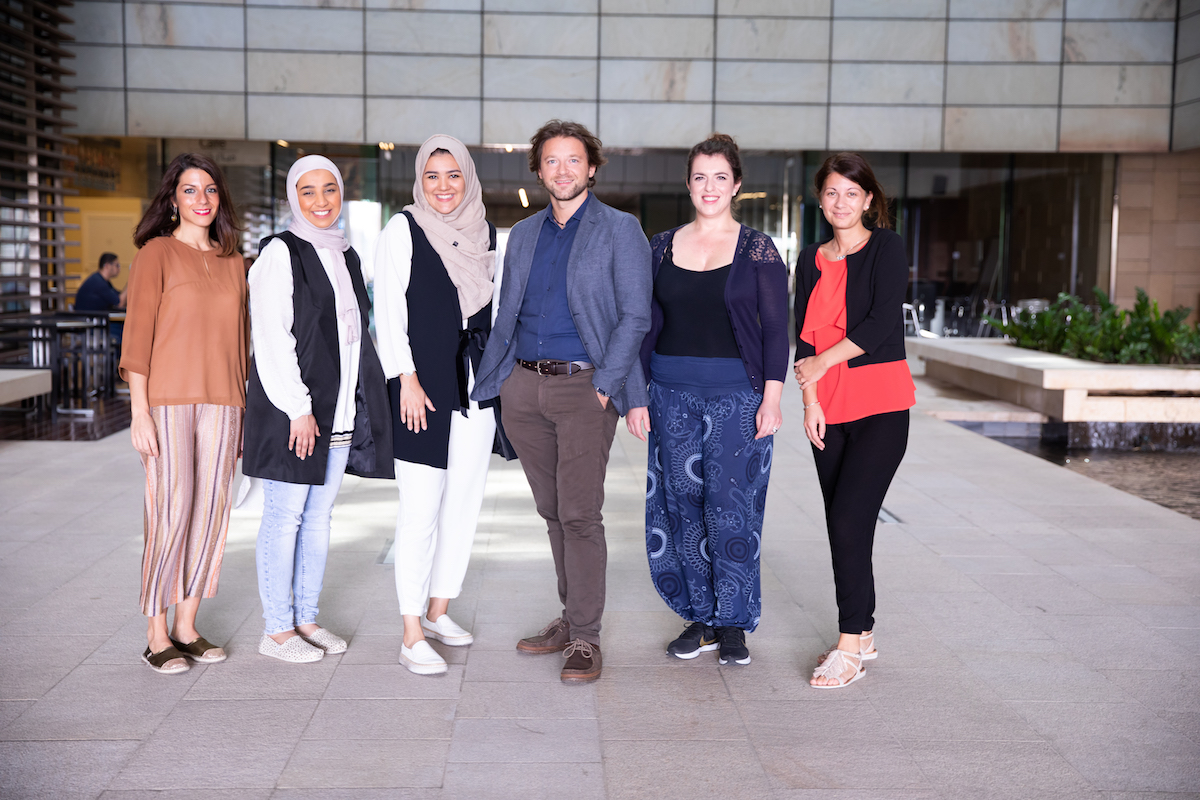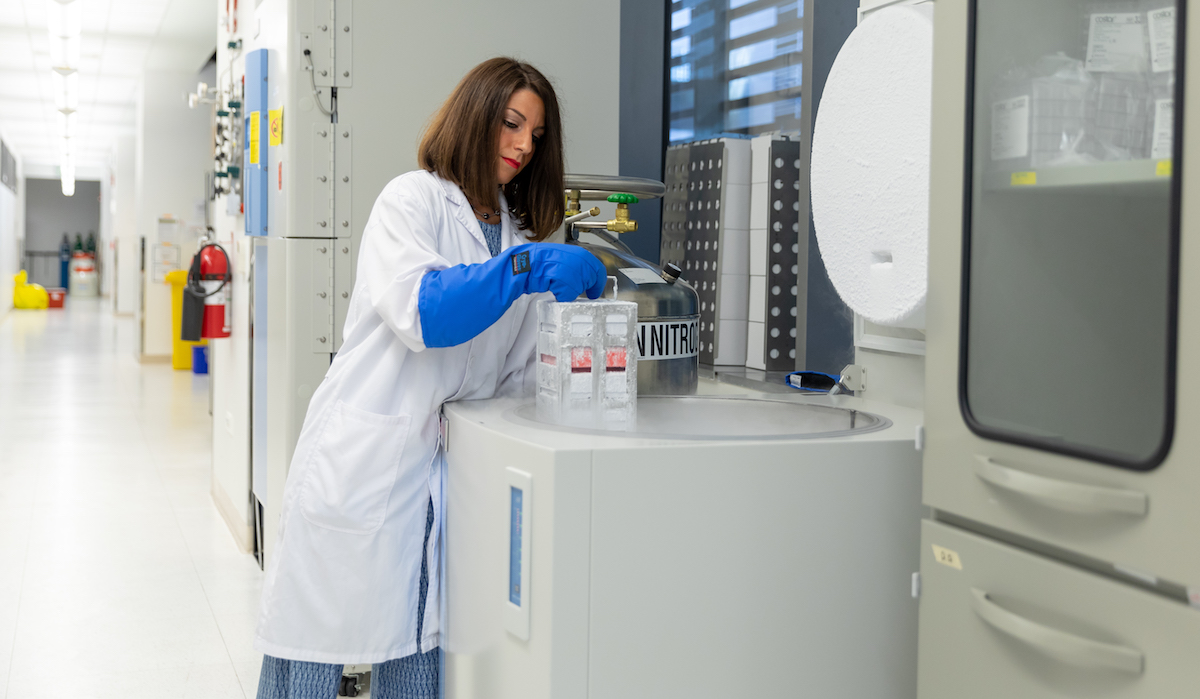Disease in a dish

KAUST Assistant Professor Antonio Adamo's Laboratory of Stem Cells and Diseases uses induced pluripotent stem cells to model diseases and help develop regenerative medicine. Photo by Sarah Munshi.
-By Sonia Turosienski, KAUST News
At birth, a baby's nascent life can set him or her on a path to become anything from a doctor to a writer to a chef. Stem cells possess a similar quality known as pluripotency, or the ability to develop into any of the three germ layers that make up the body's cells. During development, stem cells form from the zygote's blastocyst in the inner cell mass. From here, these embryonic stem cells have the potential to divide and renew through a process known as differentiation in order to give rise to specialized cells, such as blood cells, heart cells or nerve cells.
Antonio Adamo, KAUST assistant professor of bioscience and principal investigator of the Laboratory of Stem Cells and Diseases, studies the progression of metabolic diseases like diabetes using stem cells in the lab. Adamo uses embryonic stem cells donated to research, as well as induced pluripotent stem cells (iPSCs). iPSCs are stem cells that do not derive from an embryo. Using an innovative reprogramming technique, Adamo makes iPSCs in the lab by taking fibroblasts, via a skin biopsy, from patients and reverting them to a pluripotent stage in the lab—essentially giving him the ability to turn back time and study the building blocks of future cells.
A (pluri) potent discovery
In the 1980s, scientists developed a technique to culture embryonic stem cells for the first time. This was a turning point in understanding cell development, and specifically pluripotency. The source of these stem cells, which was human embryos, was controversial.
Critics argued that the embryos, which needed to be destroyed in order to produce a stem cell culture, constituted human beings and should be protected. However, research on embryonic stem cells held the promise of aiding the understanding and treatment of myriad diseases. A discovery in 2006 by researcher Shinya Yamanaka, for which he was awarded the Nobel Prize in 2012, found that mature cells can be reprogrammed to become pluripotent, negating the ethical issues associated with embryos.
Adamo explained that the 2006 discovery opened up two new research areas: disease modeling and the study of transcriptional and epigenetic factors relevant to disease. By reverting cells from patients with diseases like diabetes, for example, scientists can observe what happens to the cells as the disease progresses in vitro, or what Adamo calls "disease in a dish."
Furthermore, researchers can study how disregulated transcriptional and epigenetic mechanisms may lead to disease onset and progression. Adamo targets enzymes, a class of proteins, in his research because of their amenability to treatment applications.
"We can study the function of proteins by removing them and then differentiating the cell into glucose sensitive cell types. Once a protein is removed, you can observe whether it is important for making, for example, beta pancreatic cells in vitro," he explained.

KAUST postdoctoral fellow Elisabetta Fiacco, a member of Professor Antonio Adamo's research group, removes frozen cell stocks from a vapor-phase nitrogen tank used to store cells long term. Photo by Asharaf K. AbdulRahman.
From building blocks to treatment
Extending the functional side of disease modeling, Adamo also works on developing protocols for regenerative medicine using the knowledge gained by studying insulin resistance and diabetes "in a dish." Adamo noted that this area of medicine will see a revolution in terms of patient outcomes.
"Currently there are phase 2 human trials taking place for a new diabetes treatment that places microencapsulation devices under the skin. The device holds beta cells, differentiated from a patient's iPSCs, that release insulin upon glucose stimulation. The porous capsule design delivers insulin efficiently, but protects the device from immune cells trying to get in, essentially removing the risk of rejection and tumors," Adamo explained. "This device is still being optimized, but I think type I diabetes will be fully treatable within the next 10 years," he continued.
Adamo and postdoctoral researcher Veronica Astro recently published a review of the current knowledge and future perspectives on epigenetic control of endocrine pancreas differentiation in vitro.
Gene editing is another technique which holds promise. Recently, a research group in Italy produced two square meters of new skin for a 7-year-old patient suffering from a severe form of epidermolysis bullosa, a monogenetic disorder that causes the skin to blister at the lightest touch.
"This has huge potential in terms of treatment. In monogenetic disorders, we are now able to target the genomic sequence, correct it and derive regenerative medicine protocols. It's just a matter of time before we can do this on a large scale after it passes trials. We are nearly there," Adamo pointed out.
Balancing external and internal validity
While the field has made leaps and bounds recently, stem cell research still faces two important challenges: variability and replicating in vivo conditions.
"Even different clones of the same iPSCs have slight variability because each fibroblast has their own story and epigenetic background. The way we try to mitigate this is by increasing the number of samples, but stem cell research is one of the most expensive research fields of biology, so we are limited by manpower and cost. For each patient, we have three independent clones and at least four to five patients and controls per experiment. We try to use controls from the same family to control for genetic variability," Adamo said.

KAUST Ph.D. student Maryam Alowaysi takes human induced pluripotent stem cells out of an hypoxic cell culture incubator in the lab. Photo by Asharaf K. AbdulRahman.
"We can now differentiate iPSCs using self-organizing culture methods that promote the formation of organoids structures, which resemble in vitro the physiological three-dimensional organization of tissues in a living human being," explained Adamo. "To replicate this in the lab, we use bioreactors that mimic bloodstream movement through shaking. This is a major advancement because it has become clear that differentiation is more successful and the resulting cells are more functional using this method."
Working at the edges of knowledge
Adamo is part of the KAUST Environmental Epigenetics Program (KEEP), which aims to unravel the fundamental epigenetic mechanism by which cells and organisms adapt to environment at large.
"The program has the power of bringing different minds together and we approach epigenetic problems from different angles," he said.
Adamo believes in the value and necessity of basic scientific research.
"It is fundamental to arriving at major advances in clinical treatments. You can't bypass this. Countries have to promote basic research because pharmaceutical companies are more focused on marketable treatments," he explained.
"Being at the edges of knowledge in terms of regenerative medicine and basic science is something that motivates me every day," Adamo noted. "Whatever we discover is something that can be applied in clinics in the next five to 10 years. We are really at the edges of knowledge. Working in biology, there are a lot of bad days, but the few good days are worth the rest."

